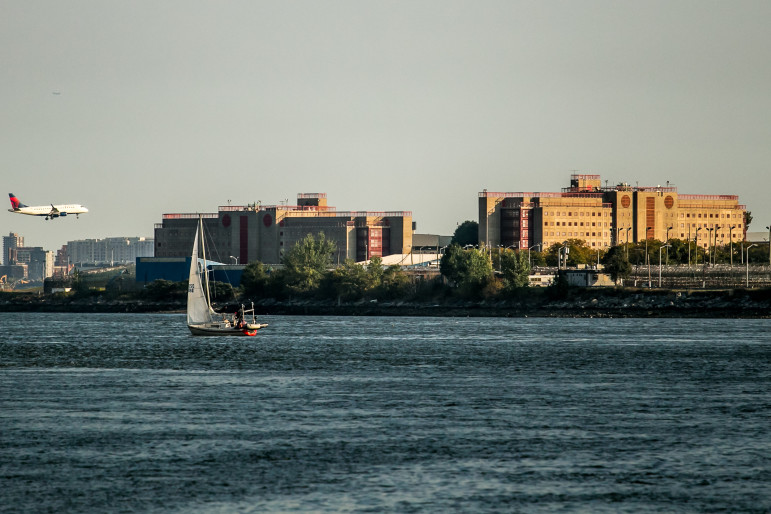
Adi Talwar
Rikers Island
The movement to close the city’s jails in Rikers Island is a critically important issue for Latinos. In 2016, Latinos made up more than 34 percent those jailed while comprising 29 percent of the city’s population. Worse yet, 14 percent of persons arrested that year were white while they composed only 7 percent of the jailed population, but Latinos represented 35 percent of all persons arrested and 34 percent of those jailed – the majority of them for low-level offenses.
Rikers, like all jails, is dangerous, but even more so because it thrives on violence, is inaccessible to families, and is hidden from view. It is part of a pretrial jail system that is half-empty but easy to forget. Every day that someone spends on Rikers, where nearly everyone is presumably innocent, is a day that produces trauma, pain and unnecessary dislocation from family and work. For far too long, New York City has taken the easy way out by looking the other way as Blacks and Latinos, already deemed of less worth, suffer from horrendous pretrial conditions and violence, and exposed to even more criminality.
The movement to close Rikers Island is not the brainchild of elected leadership. The movement is led by the very people most impacted by pretrial detention, by their families and friends and supporters. I am one of their supporters who had the opportunity to study the harm and, along with the other members of the Lippman Commission – the body of advocates and leaders appointed by former Council President Melissa Mark Viverito—proposed a blueprint for closing the cruelty that lies in the Rikers jail culture. That plan confronted an average daily population of 9,500 at Rikers. Today, we have 7,000 people in city jails with estimates placing it, in a few years, at 3,000 people. In a city of 8.2 million residents and millions of visitors every year, this is a remarkable feat in the transformation of criminal justice systems.
The Commission led to a policy change by Mayor de Blasio which is now embodied in a land use review process that requires the City Council to approve the replacement of Rikers beds with jails closer to families in four boroughs. Public funds are clearly needed, and replacement capacity is necessary because the current capacity of non-Rikers jails is below 2,300 beds and all of them are decrepit and incapable of providing programming for other services that would make pretrial detention more humane.
Here lies the heart of many objections: Are we able to, and should we, create more humane cages? Our goal in the community-led movement is to not only close Rikers, but to finally discard the notion that imprisonment is an acceptable form of social control. If the goal is to eliminate the danger and do no further harm, then what exactly do we mean if we accept new jails that would be more humane?
Opinion: 11 Reasons Why De Blasio’s $11 Billion Jails Plan Will Fail
It means that we must work within a vision towards abolition by rejecting the notion that jails are an acceptable place for our people to receive mental health services, become educated, or avail themselves of social services that should be provided to them in the community. Jails cage poor people of color and inculcate violence, inflict trauma and contribute nothing to public safety. Indeed, they divest public dollars from the very programs that would render them obsolete: education, health treatment, job creation and sustainability.
It means that since New York City is replacing jails within a diminishing caged population, not building jails to increase capacity, those new facilities must be designed with repurposing in mind, not permanency.
And it means that in the meantime, the movement must have a principled way to address how to segregate those among us who commit violent acts that upholds the needs of their victims without depending on law enforcement, prosecutors and courts. Until we address violence head on – from our nation’s sordid violent history of conquest and slavery, to interpersonal violence in our neighborhoods, to the structural violence of systemic discrimination—we will never fully abolish the cages that dominate our societal response to crime.
I can see a day when Rikers jails are permanently closed – it requires legislation to ensure that any mayor will not backtrack and keep that closure in mind – and that is still our immediate goal. Today, if it takes smaller, replacement jails to close Rikers, then the mayor and the City Council must pay heed. We will then eventually need to close the new ones as well.
Juan Cartagena is the president and general counsel of LatinoJustice PRLDEF.









One thought on “Opinion: Close Rikers to Address the Violence of Jail Discrimination – For Now”
There is a solution to closing Rikers Island, helping the men/women prisoners, with getting a GED, job readiness, a job, and permanent housing, so they can migrate back into society. But, the catch, the city must offer them, temporary housing, separate buildings to live in, until they complete personal goals, step by step. A monthly cash stipend of $200.00, a monthly metro card, snap benefits must be in place, for them to complete these self sufficiency goals. A lot of the prisoners are book smart, I know because I saw many of them take tabe tests in that “A,” booklet, after being given the locator tabe, to measure reading levels, in work related welfare programs. This can be done to house/help the prisoners but this conversation is a sit down discussion, about decisions being made before emptying and closing the doors on Rikers Island altogether. Strict rules under authority would be in place to oversee the temporary housing for the prisoners, etc…